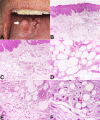Intraoral lipoma with degenerative changes mimicking atypical lipomatous tumor: an immunohistochemical study
- PMID: 36619259
- PMCID: PMC9815838
- DOI: 10.4322/acr.2021.413
Intraoral lipoma with degenerative changes mimicking atypical lipomatous tumor: an immunohistochemical study
Abstract
Lipomas are mesenchymal neoplasms relatively uncommon in the oral cavity. Lipomas can exhibit histopathological features mimicking atypical lipomatous tumors (ALT) or dysplastic lipoma (DL) in the presence of degenerative changes. Relevantly, immunohistochemistry assists in the correct diagnosis. Herein, we present the case of a 54-year-old male with a sessile nodule located on the dorsum of the tongue. The histopathological analysis showed a diffuse, non-circumscribed adipocytic proliferation constituted by cells of variable size containing cytoplasmic vacuoles and displaced nuclei, some resembling lipoblasts supported by fibrous connective tissue stroma. By immunohistochemistry, tumor cells were positive for vimentin, S100, FASN, CD10, and p16. Rb expression was intact. Moreover, CD34, p53, MDM2, and CDK4 were negative. After 2-year of follow-up, no alteration or recurrence was observed. In conclusion, MDM2, CDK4, p53, and Rb immunomarkers can be used reliably to differentiate benign lipoma with degenerative changes from ALT and DL.
Keywords: Immunohistochemistry; Lipoma; Liposarcoma; Mouth.
Copyright © 2023 The Authors.
Conflict of interest statement
Conflict of interest: All authors declare that they have no conflict of interest.
Figures




References
Publication types
LinkOut - more resources
Full Text Sources
Research Materials
Miscellaneous

